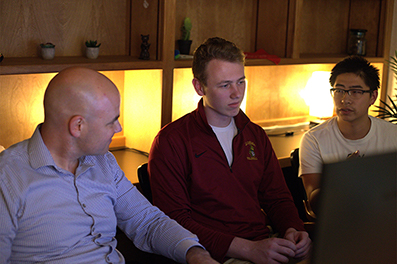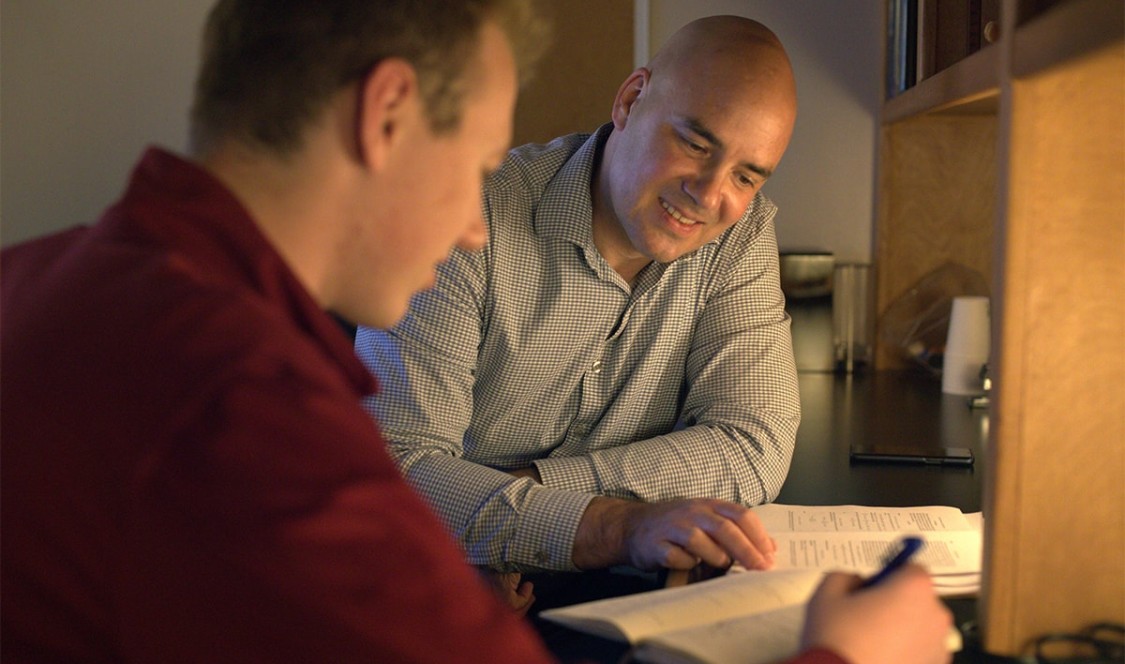Ben Gillen had worked with the best and brightest at Caltech. CMC students raised the bar.
So, how does Gillen’s new algorithm for strategic investment decisions work?
Traditional optimization techniques struggle to create effective portfolios that contain many securities even with relatively long return histories. Gillen’s algorithm overcomes these data limitations by grouping securities into smaller clusters to form a group of balanced portfolios. By diversifying across these “subset portfolios,” his algorithm robustly separates the signal from the noise in historical return data.
If the algorithm can be developed into a working tool for investing, it could provide a valuable device for institutional and large-scale investors who manage portfolios spanning a large number of securities.
Ben Gillen, assistant professor of economics, has created a potentially game-changing algorithm for quantitative investing, which uses mathematical and computer modeling to optimize the risk and return of portfolios. His research, which is supported by CMC's Financial Economics Institute, may significantly improve the ability of computers to inform investment decisions with limited data.
Now in his second year at CMC, Gillen credits his latest breakthroughs to surprising new resources he’s discovered at the College: his undergraduate research assistants.
His CMC students have “a willingness to tackle questions in a fearless manner, go out and experiment, just do it and see what happens,” Gillen said. “A grad student would get all caught up with the modeling and theory.”
Coleman Cornell ’21, a junior majoring in economics, is one of the indispensable undergraduates at his side. He joined Gillen’s research team at the Financial Economics Institute last summer.
“Let me tell you about Coleman,” Gillen says, beaming with avuncular pride. At their first work meeting, the FEI-based investigator had directed his new research assistant to read the academic paper explaining his method. The 71-page paper presents a dense mathematical exposition of the algorithm, including hints at refinements that focus on how to best diversify across the clustered “subset portfolios.”
“I asked Coleman to think about it,” Gillen recalls.
At their second meeting, Cornell brought code.
Gillen was both stunned and delighted.
“Coleman had already started working on implementing this refinement that I’d only sketched out in a very vague way,” he says.
Cornell spent the summer running thousands of data-intensive simulations on sample portfolios of many sizes at all different risk and return levels. Gillen calls his newest research assistant’s contribution “a genuinely meaningful refinement to the algorithm. I’m in the process of revising this paper,” he adds, “and some of the figures that Coleman put together will go into the next draft.”
Another research assistant who has knocked Gillen’s socks off is Jingcheng “Eric” Zhu ’20.
Gillen found his algorithm “works amazingly in simulation,” but “in the real world, asset returns change, expectations change, risk changes.” Eric, he said, has been able to get the algorithm to perform better with real data, by “looking at how to go about estimating the inputs to the algorithm, playing with lots of different approaches.”

As with Cornell, Gillen merely instructed Zhu, a Shanghai native, to read his paper and think about the problem.
When Zhu returned, he, too, came armed with code.
Gillen’s first research assistant, Seth Taylor-Brill, was similarly “awesome” and “amazingly self-starting” in exploring approaches to select the tuning parameters for the algorithm. Now a senior with double-majors in PPE and economics, Taylor-Brill is back in the Bauer Center research lab after a summer interning with the FDIC.
Gillen dreams of growing his current team. He’s hoping to bring two more students onto his team this Spring.
“I hope to eventually reach a point where I have a crew of six to eight RAs who are just working on their own little projects. In my ideal world, these students train each other, so I can sit back and harvest a lot of research while the kids do all the work,” he says, with a laugh.
It’s hardly a one-way street, however.
“The students are learning great quant skills that are rare and in high demand,” Gillen says. “My job here is first to be an educator and a mentor—to help these students grow and develop and learn things that they will be able to use in life.”
It pleases Cornell to be given so much autonomy. He plans to write his senior thesis on his project in Gillen’s research group.
“Professor Gillen doesn’t like his RAs doing busy-work,” notes the La Cañada-Flintridge native, whose parents, Karen Cornell ’84 and Curtice Cornell ’85, are CMC alumni and retired financial professionals. “I have my own entire project. I answer to him, but it’s my own work coming to fruition. I see results, and I’m happy with that.”
If it leads to a deeper understanding of Gillen’s algorithm and its applications, better still.
“In engaging on financial research, these students are head-and-shoulders above the students I had at Caltech,” Gillen says. “They’re so interested and driven. It makes them so much fun to work with. I wish I had enough bandwidth to work with 20 of them at a time.”
—Diane Krieger
Photo by Nezihe Atun '20

